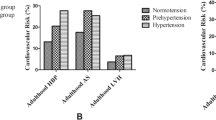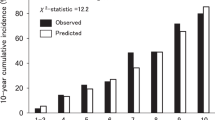Abstract
Few prospective studies have examined associations of lifestyle factors or variables in the insulin resistance syndrome (syndrome X) with incidence of elevated blood pressure (BP) in black subjects and women. This report estimates the 10-year incidence of high blood pressure (HBP) and high normal blood pressure (HNBP) in the biracial cohort of the Coronary Artery Risk Development in (Young) Adults Study (CARDIA), and examines lifestyle factors and four syndrome X variables, measured at baseline, as predictors. CARDIA examined 5115 black and white men and women aged 18–30 years in 1985–1986, and re-examined them at 2, 5, 7, and 10 years. The 10-year incidence of HBP was 16.4% in black men, 7.8% in white men, 13.1% in black women, and 3.2% in white women, while the 10-year incidence of HBP or HNBP was 29.5%, 16.2%, 19.2%, and 6.3%, respectively, in the four sex–race subgroups. Predictors included body mass index, waist circumference, physical activity, alcohol intake, pulse rate, cigarette smoking, education, fasting insulin, triglycerides, uric acid, and high-density lipoprotein cholesterol, as well as age and systolic BP. In univariate analyses, each of these variables was significantly related to incidence in at least one of the four sex–race groups. In multivariate analyses that included control for age and systolic pressure, independent predictors included fasting insulin in white men and women, triglycerides in white men, uric acid and pulse rate in black men, waist circumference in white men and black women, and education (inverse) in white men and black and white women. These results suggest that lower socioeconomic status, as assessed by education level, and one or more syndrome X variables, ie, fasting insulin, triglycerides, uric acid, may be associated with development of elevated BP in young adults.
This is a preview of subscription content, access via your institution
Access options
Subscribe to this journal
Receive 12 digital issues and online access to articles
$119.00 per year
only $9.92 per issue
Buy this article
- Purchase on Springer Link
- Instant access to full article PDF
Prices may be subject to local taxes which are calculated during checkout
Similar content being viewed by others
Author information
Authors and Affiliations
Rights and permissions
About this article
Cite this article
Dyer, A., Liu, K., Walsh, M. et al. Ten-year incidence of elevated blood pressure and its predictors: The CARDIA Study. J Hum Hypertens 13, 13–21 (1999). https://doi.org/10.1038/sj.jhh.1000740
Received:
Accepted:
Published:
Issue Date:
DOI: https://doi.org/10.1038/sj.jhh.1000740
Keywords
This article is cited by
-
Development of a risk prediction score for hypertension incidence using Japanese health checkup data
Hypertension Research (2022)
-
Cardiovascular risk in patients receiving antihypertensive drug treatment from the perspective of endothelial function
Hypertension Research (2022)
-
Variation in serum urate levels in the absence of gout and urate lowering therapy
BMC Rheumatology (2021)
-
Resting heart rate and its dynamic change and the risk of hypertension: The Rural Chinese Cohort Study
Journal of Human Hypertension (2020)
-
Neck circumference associated with arterial blood pressures and hypertension: A cross-sectional community-based study in northern Han Chinese
Scientific Reports (2017)



